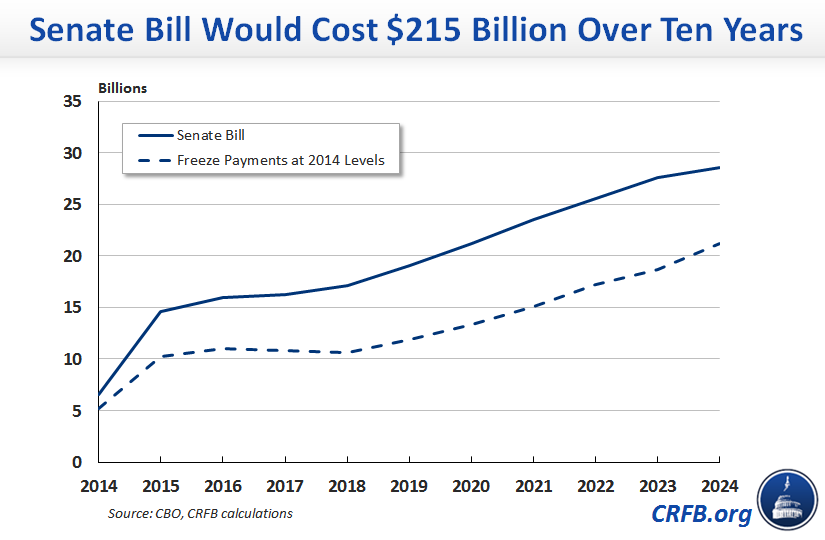CBO: Senate "Doc Fix" Would Add $215 Billion to the Debt
The Congressional Budget Office (CBO) released a new estimate of the fiscally irresponsible Senate “doc fix” bill, showing it would increase Medicare spending by $180 billion over the next ten years, adding $215 billion to the debt by 2024 when interest costs are included.
As we showed last week, 98 percent of doc fixes since 2004 have been fully paid for with savings elsewhere in the budget, generating $140 billion of deficit reduction. It would be a costly mistake to break that precedent now, as the Senate Democrats would do explicitly and House Democrats and Republicans would do implicitly through the use of budget gimmicks.
The Senate Democratic bill would avoid a scheduled 24 percent cut in physician payments and replace the Sustainable Growth Rate (SGR) formula for Medicare physician payments with a new system designed to better encourage quality over quantity of care. In addition, it would make permanent a host of temporary provisions often referred to as the “health extenders.” Doing so without offering offsetting savings adds $40 billion to $140 billion to the cost of SGR reform. Interest costs add another $35 billion, for a total cost of $215 billion over the next ten years.
The $215 billion that the legislation adds to the debt is not only far more than current law, but it is a substantial increase over the $145 billion cost (with interest) of freezing physician payments for ten years as is assumed in the baseline of the President’s budget.
To meet the minimum test of fiscal responsibility, lawmakers should work to offset the cost of the legislation. $180 billion of non-interest savings may sound like a lot, but nearly every major health care reform proposal issued in recent years has recommended budget savings far in excess of this amount.
The legislation could be offset by using 45 percent of the health savings recommended by the President, for example. Or 65 percent of what the Senate Democrats supported just last year in their budget. Or just 40 percent of the health savings recommended in a joint proposal from former Senators Domenici, Daschle, Frist, and Alice Rivlin (25 percent if their health-related revenue proposals are included).
| Health Savings vs. Cost of Doc Fix Bill | ||
| Plan | Ten-Year Health Savings (billions)* | Percent of Health Savings Needed For Doc Fix Bill |
| President's FY2015 Budget | $400 | 45% |
| Senate FY2014 Budget (Dems) | $275 | 65% |
| House FY2014 Budget (GOP) | $940 | 20% |
| Domenici-Rivlin-Daschle-Frist | $435/$700^ | 40%/25%^ |
| Bipartisan Path Forward | $585 | 30% |
| Center for American Progress | $385/$485^ | 45%/35%^ |
| National Coalition for Health Care | $220/$495^ | 80%/35%^ |
Note: Numbers include Medicare and non-Affordable Care Act Medicaid savings only except where noted.
*Ten-year windows vary across plans and are not adjusted to be in the same timeframe.
^Second number includes health care-related revenue.
Policymakers could pick and choose from these plans and others. There are plenty of options to choose from in properly offsetting a permanent doc fix, not only from these plans but from the Congressional Budget Office, MedPAC, and numerous other sources.
The CBO score of the Senate bill should underscore the importance of paying for a permanent doc fix. Failing to do so would be a costly break with precedent and a completely unnecessary one.



